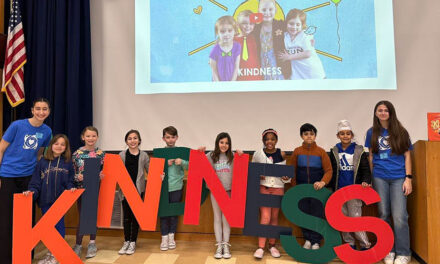Published June 12, 2019
By DAN TOMASELLO
LYNNFIELD — A new mediation and mindfulness program is paying dividends at Lynnfield High School, Science Department Head Scott Gordon and Foreign Language Department Head Julie Sgroi told the School Committee recently.
Gordon said the new initiative has been implemented in order to help students overcome stress and shift their focus to their schoolwork.
“Meditation is a means of transforming the mind,” said Gordon. “It encourages and develops concentration, clarity, emotional positivity and intuition. The process of meditation follows a particular order, has definite principles and produces results that can be verified.”
Gordon said, “Mindfulness is one form of meditation.”
“It is the primary style that we introduce at the high school,” said Gordon. “It’s an easy one to introduce. Mindfulness is simply paying attention to what is going on in the present moment. It is not about daydreaming or being lost in thought. It’s about being aware of what is going on outside of us as well as inside of us.”
Sgroi said mindfulness intervention programs have been used throughout the United States for over 30 years.
“In 1982, there was research done which showed mindfulness had positive effects on chronic pain, stress, well-being, improved memory, immune response, self control, addiction recovery and resilience,” said Sgroi. “In 1983, three peer review studies were published on meditation. That number is now over 1,000 studies a year. It’s something that is gaining momentum because there is a lot of positive research behind it.”
Sgroi noted Harvard University researcher Britta Hölzel released a study in 2011 that “showed meditation increases the gray matter in the brain involved with memory, emotion regulation and perspective.”
“Meditation can make you smarter,” said Sgroi. “In 2009, a study of adolescents between the ages of 14 through 18 showed reductions in stress, depression, anxiety and increased self-esteem and sleep quality as a result of mindfulness. These are the things we hear from the students. They are stressed and they have anxiety. Some students have self-esteem issues, and most high school students don’t get enough sleep. Increasing their sleep quality as a result of this is definitely something that is going to have positive results.”
Gordon said meditation and mindfulness can have a positive impact on the brain. He said the brain’s prefrontal cortex is “the part of the brain where problem-solving occurs.” He said the hippocampus is where “memories are stored.”
“So when we use our prefrontal cortex to learn a new problem-solving skill, we store that memory in the hippocampus,” said Gordon. “When we come across a time where we need to pull that memory back and use that information, we have to recall that from the hippocampus. That is how the mind works.”
Gordon noted the amygdala is “sometimes referred to as the lizard part of the brain.”
“(The amygdala) is the emotional center responsible for the fight, flight or freeze response,” said Gordon. “When we need our minds to help us survive, that is the part of the brain that takes over. It shuts down the other parts. The problem is when we get stressed, that is the part of the mind we are in. There is no reason children should be in that part of their minds, yet they are. And when they are in that part of their mind, children are not accessing the prefrontal cortex to solve problems.”
Gordon noted a number of high school students have experienced anxiety before taking a test, and said that anxiety consumes the amygdala and overrules the prefrontal cortex and hippocampus. By using meditation and mindfulness skills, Gordon said students are able to alleviate their anxiety and in turn can take the test.
“They calm down and remember how to solve the problem,” said Gordon. “They always knew how, but they can’t access it when they are stressed.”
Gordon said mindfulness trains people to “create space between impulse and action, and to observe emotions in addition to feeling them.”
“In doing so, we can dissociate from them,” said Gordon. “The minute you recognize the emotion, the prefrontal cortex comes back into play and works again. You’ve recognized and identified the emotion. The amygdala becomes deactivated, stress decreases, stress chemical production slows, and the prefrontal cortex and hippocampus can work again allowing for learning. The entire point of mindfulness is to allow students to create that space and observe what is going on in their own minds. And when they observe it and recognize it, that space is there and they go back to using the parts of the brain they are used to using. This program at Lynnfield High School is about creating that space so students can have a better response.”
Sgroi noted she and Gordon have visited classrooms to teach mindful listening techniques pertaining to breathing, focus and posture.
“We go through one minute of mindful listening,” said Sgroi. “The teachers can then take our training and can use it whenever they want. Two teachers in the Foreign Language Department have done this every day for the entire year. And students are actually requesting it. If one of the teachers skips it because they forgot about it, the students will remind them about it. They look forward to that moment of a little bit of space.”
Sgroi said the Compass Program’s student advisors have been using meditation and mindfulness during “passion-driven learning sessions.”
“That is 45 minutes on the last Friday of every month,” said Sgroi. “While there, they can practice different styles of mindfulness.”
Sgroi said the high school has given students the opportunity to learn more about meditation and mindfulness if it interests students.
“What Scott and I have asked them to do is meditate on their own a certain number of times each week,” said Sgroi. “Students keep a notebook about how often they have meditated and for how long. And for once during the high school’s seven-day cycle, they meditate with us for 10 minutes. Most of the time, the students were coming back daily. They were really interested in learning about other ways to meditate and other practices. That is a skill they are going to take with them for the rest of their lives. A lot of students really look forward to it.”
Sgroi noted the two teachers have coordinated over 140 individual meditation events in addition to what the teachers have undertaken in their respective classes over the course of the school year.
“If you add our classes, it would be double or triple,” Gordon added.
The two department heads read a number of quotes from anonymous students who praised the meditation and mindfulness program at the high school.
“Ever since I have started meditating, I have noticed that it has significantly reduced stress for me and puts me into a more calm, relaxed mood,” said Sgroi while quoting a student. “It also helps me with my school work when I feel as if I don’t want to do it, I suddenly have the urge to get it done.”
Gordon said the program “has been transformative for a number of students in the school.”
SC reaction
School Committee member Stacy Dahlstedt inquired if students are practicing meditation and mindfulness at home. She also asked if parents have been informed about the program.
“The students are practicing at home regularly,” said Gordon. “In terms of parent communication, I have had one or two parents contact me directly and I have had some students who suggested meditation for their parents. I believe they are training them.”
School Committeeman Phil McQueen said the program is “a great initiative” for the high school.
“Thank you for doing this,” said McQueen.
Sgroi said she would like to expand the program next year.




